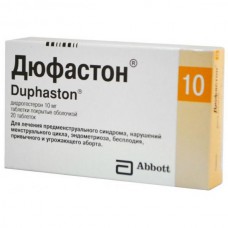Expiration date: 03/2026
Structure and Composition:
Film-coated tablets. 1 tablet contains 10 mg dydrogesterone
Excipients: lactose monohydrate hypromellose corn starch colloidal silicon dioxide, magnesium stearate
shell: Opadry White Y-1-7000 (Valium, polyethylene glycol 400, titanium dioxide (E171)
in blister 20 pcs. in a cardboard box 1 blister.
Description pharmaceutical form:
Round, biconvex tablets white, with beveled edges, coated, engraved «S» sign of "6" on one side of the tablet with the mark and the sign "155" on both sides of the risks - to another.
Pharmacokinetics:
After oral administration, dydrogesterone is rapidly absorbed from the gastrointestinal tract, Cmax is achieved in 2 hours in plasma. Plasma protein binding is 97%. Metabolism occurs in the liver through hydroxylation of the ketone group of 20 carbon atoms. Along with this, also observed hydroxylating methyl groups of 21 carbon atoms and in a very slight amount - 16- & alpha carbon atom. The urine output from 56 to 79% after 24 h is displayed about 85%, at 72 hours removal process is almost ended. Recorded delay or enhance the action of dydrogesterone have been reported with limited kidney function today. Metabolites detected in the urine mainly as glucuronic acid conjugates. Presence of unchanged substance in urine is detected.
Description of the pharmacological actions:
Duphaston (dydrogesterone) - a progestogen, orally active. Dydrogesterone in its molecular structure, chemical and pharmacological properties very similar to natural progesterone. Due to the fact that not a dydrogesterone derivative of testosterone, it has no side effects typical of most synthetic progestogens, so-called "Androgenic" progestogens. Dydrogesterone has no estrogenic, androgenic, anabolic, glucocorticoid and thermogenic activity. Acting as a progestogen component of hormone replacement therapy (HRT) in menopause, dydrogesterone contributes to the preservation of a favorable action of estrogen on the blood lipid profile. However, unlike estrogen, which normally adversely affect the blood clotting system, dydrogesterone has no effect on the coagulation parameters. Not adversely affect carbohydrate metabolism and liver function. Dydrogesterone with oral selectively acts on the endometrium, thereby preventing an increased risk of endometrial hyperplasia and / or carcinogenesis with an excess of estrogen. It is indicated in all cases of endogenous progesterone deficiency. The drug has no contraceptive effect. In the treatment of dydrogesterone therapeutic effect is achieved without suppressing ovulation or menstrual dysfunction. Didrogesteron allows conception and continuation of the pregnancy during treatment.
Testimony:
Progesterone deficiency: endometriosis, infertility due to luteal insufficiency habitual miscarriage and threatening to set the background of progesterone deficiency, premenstrual syndrome, dysmenorrhea, irregular menstruation, secondary amenorrhea (in combination with estrogen therapy), dysfunctional uterine bleeding.
HRT: to neutralize the proliferative effect of estrogens on the endometrium in the framework of HRT in women with disorders due to natural or surgical menopause with an intact uterus.
Contraindications:
Hypersensitivity to dydrogesterone or other components of the preparation.
Be wary - itchy skin during the preceding pregnancy.
Currently no data about the negative effect of dydrogesterone in patients with chronic renal failure patients.
Application of pregnancy and breastfeeding:
The drug can be used during pregnancy (see. "Indications" field). Dydrogesterone is excreted in breast milk, so breast-feeding is not recommended during treatment.
Side effect:
From hemopoiesis system: in rare cases - hemolytic anemia.
Immune system: very rarely - hypersensitivity reactions.
CNS: headache / migraine.
On the part of the hepatobiliary system: rarely - minor liver dysfunction, sometimes accompanied by weakness or malaise, jaundice and pain in the abdomen.
Reproductive system: in rare cases, you may experience breakthrough bleeding, which can be prevented by increasing the dose of the drug increased sensitivity of mammary glands.
Skin and subcutaneous tissue: rare - skin rash, itching, rash, very rarely - angioedema.
General disorders: very rarely - peripheral edema.
Drug Interactions:
Inductors of microsomal liver enzymes (phenobarbital, rifampin) may accelerate the metabolism and reduce the effects of dydrogesterone.
Dosage and administration:
Inside. Endometriosis: 10 mg 2-3 times a day with a 5 to 25 day cycle or continuously.
Infertility (caused by luteal insufficiency): 10 mg / day with a 14 to 25 day cycle, the course is carried out continuously for 6 consecutive cycles and boleerekomenduetsya continue treatment in the first months of pregnancy (as with habitual abortion).
Threatened abortion: 40 mg once daily, and then - 10 mg every 8 hours until symptoms disappear.
Habitual abortion: 10 mg 2 times a day up to 20 weeks of pregnancy, followed by a gradual reduction in dose.
Premenstrual syndrome: 10 mg 2 times a day with a 11 to 25 day cycle.
Dysmenorrhea: 10 mg 2 times a day, from 5 to 25 day cycle.
Irregular menses: 10 mg 2 times a day with a 11 to 25 day cycle.
Amenorrhea: estrogens - 1 time per day 1 to day 25, Djufaston - 10 mg 2 times a day with a 11 to 25 day cycle.
Dysfunctional uterine bleeding: to stop bleeding - 10 mg 2 times a day for 5-7 days for the prevention of bleeding - 10 mg 2 times a day with a 11 to 25 day cycle.
HRT with estrogens in combination: the continuous estrogen regimen - 10 duphaston 1 mg once a day for 14 days within 28-day cycle. When the cyclic pattern of estrogen: Duphaston - 10 mg 1 time per day during the last 12-14 days of estrogen. If a biopsy or ultrasound evidence of a lack of response to the progestogen drug, dydrogesterone daily dose should be increased to 20 mg.
Overdose:
Posts about the symptoms of overdose have been reported. When receiving the random at a dose considerably higher than the therapeutic recommended gastric lavage.
Treatment: symptomatic. There is no specific antidote.
Special instructions:
Some patients may experience breakthrough bleeding, which is prevented by increasing the dose. In the case of treatment with dydrogesterone in combination with estrogen (eg HRT) should carefully read the contraindications and warnings associated with the use of estrogen. Before you start using a combination of dydrogesterone and estrogen (HRT) should be compiled complete medical history. During treatment, it is recommended to periodically check the individual tolerability of HRT. The patient should be informed about any changes in her breasts should be reported to your doctor or nurse. Studies, including mammography, should be carried out in accordance with generally accepted screening patients. In women receiving HRT, accurate assessment of risks and benefits is estimated over time. Sometimes, during the first months of treatment, you may experience breakthrough bleeding. If breakthrough bleeding occurs after a period of drug administration or continue after the course of treatment, should examine the cause, make endometrial biopsy to exclude the malignant changes in the endometrium.
Conditions that must be monitored: patients should be thoroughly evaluated with a history progesteronzavisimoy tumors (eg meningiomas), as well as in case of progression during pregnancy or during the pre-hormone therapy.
Other conditions: patients with genetically determined galactose intolerance, lactase deficiency or malabsorption should not take this drug.
The drug does not affect the ability to drive a car and other mechanisms.


